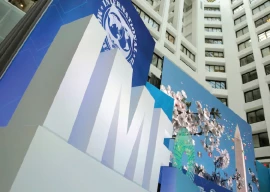
The Manila-based lending agency has advised Pakistan to tighten the monetary policy and let the rupee further depreciate to tackle external account challenges.
Owing to the widening current account deficit, “securing adequate financing to contain the drawdown in foreign exchange reserves is a concern,” cautioned the ADB in its annual flagship publication, Asian Development Outlook (ADO) 2018.
The bank’s report indicates another stormy year ahead for Pakistan’s economy as it sees higher current account and trade deficits coupled with a decline in economic growth and official foreign currency reserves.
PM’s aide going to attend IMF meetings just days before budget
The ADB’s findings are contrary to the government’s assessment that expects low pressure on the external account due to implementation of a majority of China-Pakistan Economic Corridor’s (CPEC) energy and infrastructure projects.
“GDP growth is expected to adjust downwards in fiscal year 2018-19 to 5.1% as balance of payments constraints seem to outweigh improvements to supply-side factors such as better security and energy supply,” said the ADB.
The government has announced that the national economy showed a provisional growth of 5.8% in the outgoing fiscal year, which was the highest in the last 12 years and fifth straight year of high growth.
The ADB said while credit growth slowed in the first eight months of the current fiscal year, demand pressures kept imports high and the resulting steady drawdown of foreign exchange reserves indicated a need for policy tightening.
“Other concerns were the rise in global oil prices and a firming outlook for higher interest rates in the US and global capital markets.”
“Pakistan’s economic prospects in coming years remain positive if budget and current account deficits are reduced and exports are rejuvenated by improving the country’s competitiveness,” said ADB Country Director for Pakistan Xiaohong Yang.
She said Pakistan could maintain a stronger growth trajectory through domestic and regional stability, improving overall competitiveness, revitalising public sector enterprises as well as timely completion and effective use of infrastructure projects.
The ADB said the flexibility in determining the exchange rate would help mitigate the erosion of competitiveness due to appreciation of the real effective exchange rate in past years.
It said the current account remained under pressure in the first eight months of fiscal year 2017-18 as the deficit rose to $10.8 billion, or 4.8% of estimated GDP for the period, from $7.2 billion in the year-earlier period.
The current account deficit would likely edge up a bit to equal 4.9% of GDP by the end of the fiscal year and in the next year it would also remain around 4.5% of GDP, it added.
The preliminary projection of 4.5% current account deficit in fiscal year 2018-19 was based on the assumption of “somewhat slower growth, but continued implementation of CPEC projects”. Successfully financing these large investments will require the government to pursue real structural reforms.
The ADB said the currency depreciation and the transmission of rising international oil prices to the domestic market were also expected to boost inflation in the second half of the year, generating average inflation of 4.5% in the outgoing fiscal year.
Inflation is projected to accelerate marginally to 4.8% in FY2019, reflecting increases in global oil prices and rupee depreciation against major currencies.
Pakistan’s ADB rep steps down two weeks after replacement announced
It said declining exports pose a major challenge to the sustainability of external accounts. Various structural weaknesses undermine Pakistan’s trade performances. In particular, weak logistics and trade facilitation, including customs procedures, add to transaction costs.
In addition, the government should consider other reforms like greater exchange rate flexibility, enforcing industrial compliance with quality control and other standards, operationalising a national single window for trade, skills development that aligns with industry demand and instituting legal and institutional frameworks to support new industries such as information and communication technology services.
Economies with relatively young current populations, such as Nepal and Pakistan, will experience larger increases in their labour force and need policies to ensure adequate number of productive jobs.
The consolidated federal and provincial budget deficit climbed to 5.8% of GDP, but due to some measures the deficit in the outgoing fiscal year may remain below last year’s level.
Published in The Express Tribune, April 12th, 2018.
Like Business on Facebook, follow @TribuneBiz on Twitter to stay informed and join in the conversation.

1732071267-0/lana-(2)1732071267-0-165x106.webp)
1727242355-0/Diddy-(1)1727242355-0-165x106.webp)

1732063440-0/elon-(3)1732063440-0-165x106.webp)












COMMENTS (1)
Comments are moderated and generally will be posted if they are on-topic and not abusive.
For more information, please see our Comments FAQ